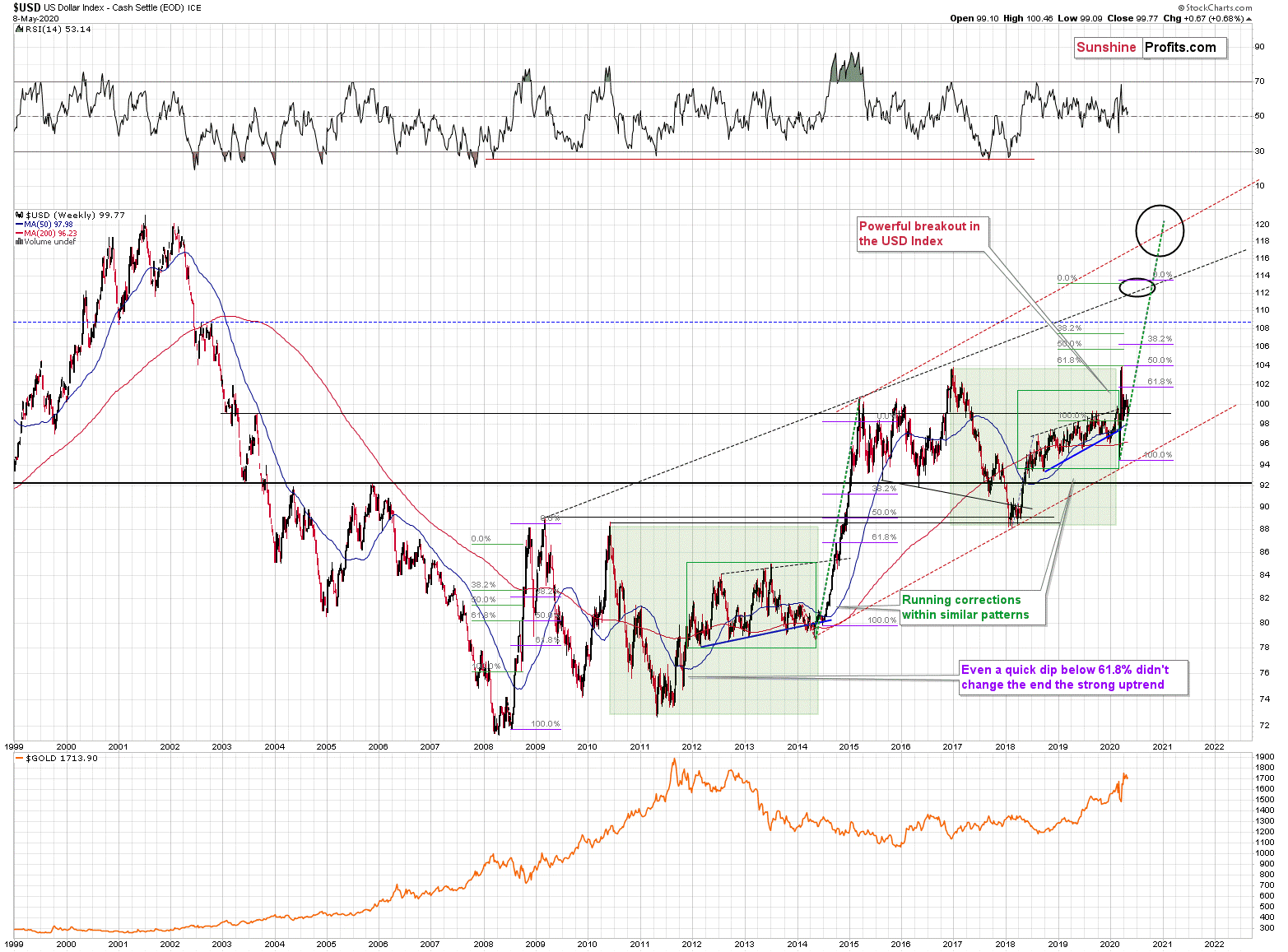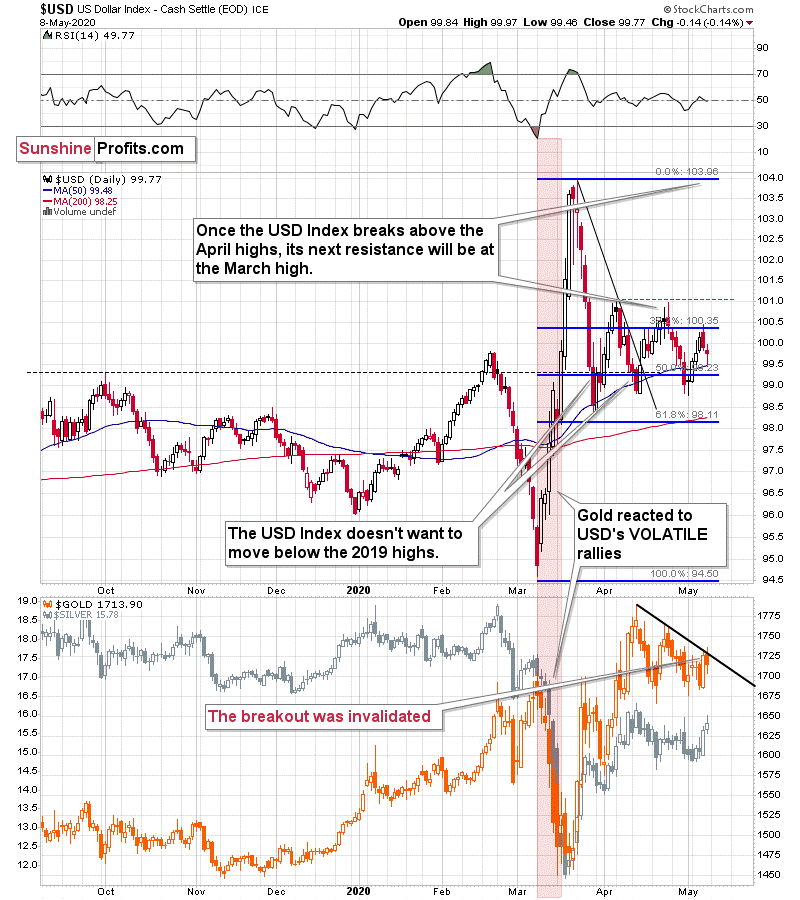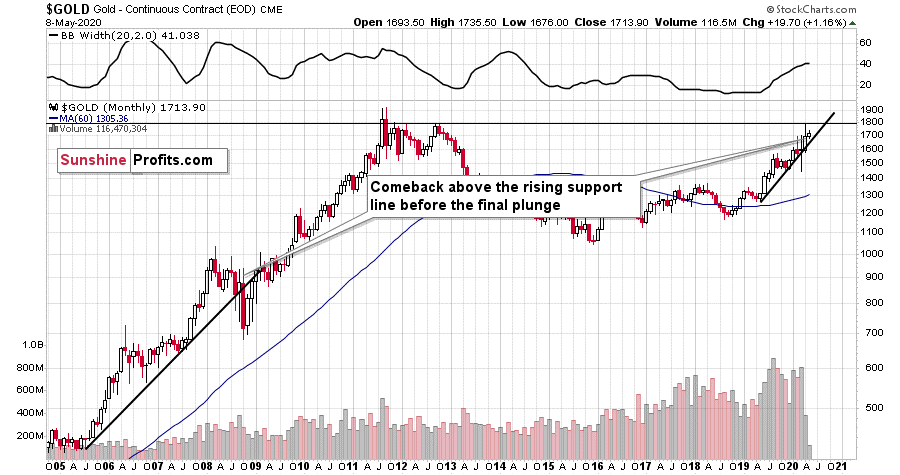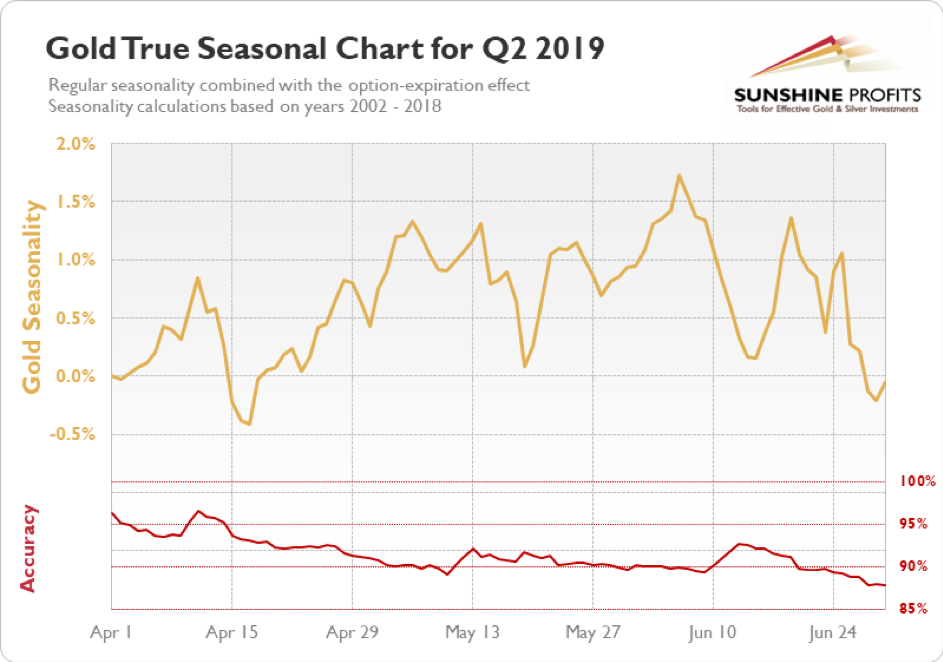The recent volatility in most markets was really extreme, which means that it was easy to lose focus on the things that matter the most in case of the gold market. It was relatively easy to keep one’s focus as far as the fundamental outlook for gold is concerned – it’s quite obvious that the economies around the world are in deep trouble and that the various QEs and money-printing mechanisms are likely to be inflationary, which together is likely to result in stagflation – which gold loves.
On the other hand, it was easy to lose focus with regard to one of gold’s key short- and medium-term drivers – the USD Index. If the USD Index soars, then gold is likely to plunge in the short run, regardless of how favorable other fundamentals are.
Consequently, in today’s free article, we’ll discuss the situation in the USD Index, with emphasis on two key similarities.

The USD Index was previously (for the entire 2019 as well as parts of 2018 and 2020) moving up in a rising trend channel (all medium-term highs were higher than the preceding ones) that formed after the index ended a very sharp rally. This means that the price movement within the rising trend channel was actually a running correction, which was the most bullish type of correction out there.
If a market declines a lot after rallying, it means that the bears are strong. If it declines a little, it means that bears are only moderately strong. If the price moves sideways instead of declining, it means that the bears are weak. And the USD Index didn't even manage to move sideways. The bears are so weak, and the bulls are so strong that the only thing that the USD Index managed to do despite Fed's very dovish turn and Trump's calls for lower USD, is to still rally, but at a slower pace.
We previously wrote that the recent temporary breakdown below the rising blue support line was invalidated, and that it was a technical sign that a medium-term bottom was already in.
The USD Index soared, proving that invalidation of a breakdown was indeed an extremely strong bullish sign.
Interestingly, that's not the only medium-term running correction that we saw. What's particularly interesting, is that this pattern took place between 2012 and 2014 and it was preceded by the same kind of decline and initial rebound as the current running correction.
The 2010 - 2011 slide was very big and sharp, and it included one meaningful corrective upswing - the same was the case with the 2017 - 2018 decline. Also, they both took about a year. The initial rebound (late 2011 and mid-2018) was sharp in both cases and then the USD Index started to move back and forth with higher short-term highs and higher short-term lows. In other words, it entered a running correction.
The blue support lines are based on short-term lows and since these lows were formed at higher levels, the lines are ascending. We recently saw a small breakdown below this line that was just invalidated. And the same thing happened in early 2014. The small breakdown below the rising support line was invalidated.
Since there were so many similarities between these two cases, the odds are that the follow-up action will also be similar. And back in 2014, we saw the biggest short-term rally of the past 20+ years. Yes, it was bigger even than the 2008 rally. The USD Index soared by about 21 index points from the fakedown low.
The USDX formed the recent fakedown low at about 96. If it repeated its 2014 performance, it would rally to about 117 in less than a year. Before shrugging it off as impossible, please note that this is based on a real analogy - it already happened in the past.
In fact, given this month’s powerful run-up, it seems that nobody will doubt the possibility of the USD Index soaring much higher. Based on how things are developing right now, it seems that the USD Index might even exceed the 117 level, and go to 120, or even higher levels. The 120 level would be an extremely strong resistance, though.
Based on what we wrote previously in today's analysis, you already know that big rallies in the USD Index are likely to correspond to big declines in gold. The implications are, therefore, extremely bearish for the precious metals market for the following months.
On the short-term note, it seems that the USD Index has finished or almost finished its breather after the powerful run-up. While the base for the move may be similar to what happened between 2010 and 2014, the trigger for this year’s sharp upswing was similar to the one from 2008. In both cases, we saw dramatic, and relatively sudden rallies based on investors seeking safe haven. The recent upswing was even sharper than the initial one that we had seen in the second half of 2008. In 2008, the USDX corrected sharply before moving up once again, and it’s absolutely no wonder that we saw the same thing also recently.
In fact, on March 23rd, just after the USDX closed at 103.83, we wrote that “on the short-term note, it seems that the USD Index was ripe for a correction.
But a correction after a sharp move absolutely does not imply that the move is over. In fact, since it’s so in tune with what happened after initial (!) sharp rallies, it makes the follow-up likely as well. And the follow-up would be another powerful upswing. Just as a powerful upswing in the USD Index triggered gold’s slide in 2008 and in March 2020, it would be likely to do the same also in the upcoming days / weeks.
Please note that the 2008 correction could have been used – along with the initial starting point of the rally – to predict where the following rally would be likely to end. The green lines show that the USDX slightly exceeded the level based on the 2.618 Fibonacci extension based on the size of the correction, and the purple lines show that the USDX has approximately doubled the size of its initial upswing.
Applying both techniques to the current situation, provides us with the 113 – 114 as the next target area for the USD Index. A sharp rally to that level (about 13-14 index points) would be very likely to trigger the final sell-off in gold, silver, and mining stocks.

On a short-term basis, we just saw a daily move lower in gold, while the USD Index declined and reversed before the end of the day. This – by itself – is a sign of gold’s weakness, but it’s a sign of strong weakness, when one takes into account gold’s recent technical development.
Namely, gold recently moved above its declining resistance line – the upper border of the triangle / pennant. A decline in the USD Index was a bullish factor for gold and it should have easily held ground. Namely, it should have rallied further and confirmed the breakout. Gold didn’t manage to do that. Instead, it declined and invalidated the breakdown. This is a profound sign of weakness.
Interestingly, while gold showed weakness, silver showed daily strength by rallying higher despite a move lower in gold. That’s exactly what we quite often see right before big declines in the precious metals market.
The above is the most important short-term technical development in gold, so we don’t discuss it separately from this point of view, but we would like to draw your attention to the following monthly gold chart.

In 2008, after the initial plunge, and a – failed – intramonth attempt to move below the rising support line, gold came back above it and it closed the month there. The same happened in March 2020.
During the next month in 2008, gold rallied and closed visibly above the rising support line. The same was the case in April, 2020.
In the following month – the one analogous to May 2020 – gold initially moved higher, but then it plunged to new lows and finally closed the month below the rising support line. We might see something very similar this month.
Speaking of this month in particular, let’s check how gold usually (seasonally) performs in May.

In short, gold usually tops in the first half of the month, and bottoms in its second half. It then recovers but moves to new highs only in June. This more or less fits what we expect to see later this month also this year.
All in all, the outlook for the USD Index is bullish, which is likely to trigger a decline in the price of gold. Ultimately, gold is likely to recover and soar in the following years, but the opposite seems more likely for the following weeks.
